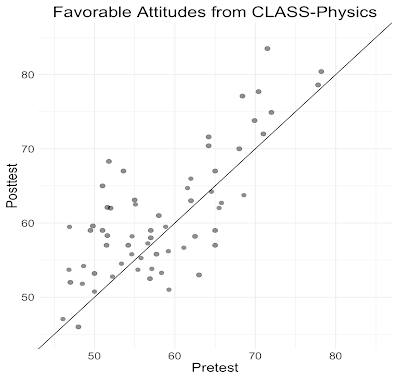Colorado Learning Attitudes about Science Survey (CLASS) - Physics
Purpose
The CLASS-Physics measures novice-to-expert-like perceptions about physics. The CLASS-Physics measures a range of attitudes that vary between experts and novices, including enjoyment of the discipline, making connections to the real world, the conceptual connections underlying knowledge, and problem-solving strategies.
Population
The CLASS-Physics is commonly administered in undergraduate physics courses from introductory to upper division.
Typical Performance
Madsen, McKagan, and Sayre (2015) reviewed studies using the CLASS and found that students attitudes typically decreased in introductory algebra-based and calculus-based physics courses when both traditional and research-based teaching practices were used. However, courses for educators that used research-based pedagogies and materials report improved student attitudes.
The following figure provides the pretest and posttest favorable attitudes for CLASS scores from both the LASSO database and the research literature.

Validity
Adams et al. (2006) developed the wording for each question using student interviews to ensure that each question has a single meaningful interpretation to students. They conducted interviews with experts to ascertain the validity and utility of the items. They used an iterative reduced-basis factor analysis to identify categories within the student responses. Validation evidence came from students at two different institutions.
Adams, W. K., Perkins, K. K., Podolefsky, N. S., Dubson, M., Finkelstein, N. D., & Wieman, C. E. (2006). New instrument for measuring student beliefs about physics and learning physics: The Colorado Learning Attitudes about Science Survey. Physical review special topics-physics education research, 2(1), 010101.
Research
An excellent starting place to overview the research with the CLASS-Physics is the following meta-analysis
Madsen, A., McKagan, S. B., & Sayre, E. C. (2015). How physics instruction impacts students’ beliefs about learning physics: A meta-analysis of 24 studies. Physical Review Special Topics-Physics Education Research, 11(1), 010115.
Example LASSO Report
Please follow this link to our example report for attitudes surveys.
More Information
For more information, please visit the Physport webpage on the CLASS-Physics.

